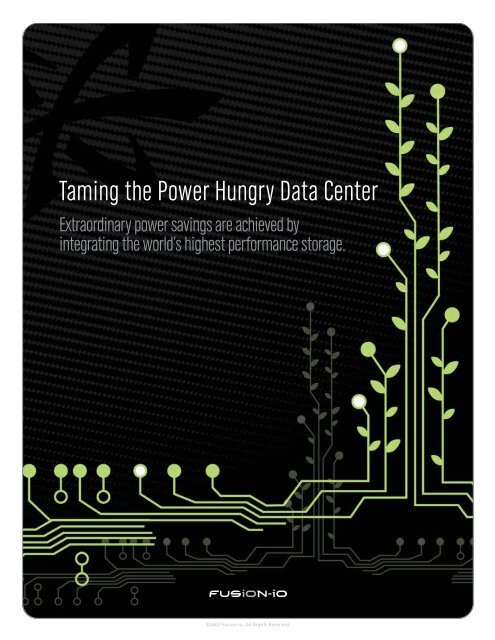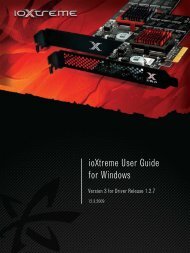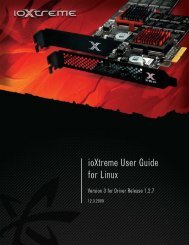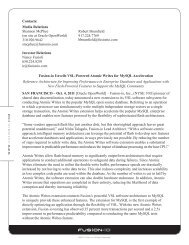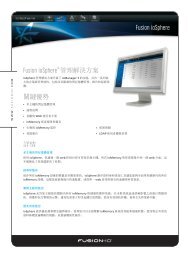Taming the Power Hungry Data Center - Fusion-io
Taming the Power Hungry Data Center - Fusion-io
Taming the Power Hungry Data Center - Fusion-io
You also want an ePaper? Increase the reach of your titles
YUMPU automatically turns print PDFs into web optimized ePapers that Google loves.
<strong>Taming</strong> <strong>the</strong> <strong>Power</strong> <strong>Hungry</strong> <strong>Data</strong> <strong>Center</strong><br />
Extraordinary power savings are achieved by<br />
integrating <strong>the</strong> world’s highest performance storage.<br />
©2007 <strong>Fus<strong>io</strong>n</strong>-<strong>io</strong>, All Rights Reserved.
<strong>io</strong>Drive <br />
The Revolut<strong>io</strong>nary Change<br />
There have been a number of unique, evolut<strong>io</strong>nary technology advances applied in today’s data center to improve system<br />
applicat<strong>io</strong>n performance, scalability, and, more recently, to reduce total power consumpt<strong>io</strong>n. Many such changes are examples<br />
of an evolut<strong>io</strong>nary change driven by <strong>the</strong> disparity between <strong>the</strong> performance of <strong>the</strong> central processor unit (CPU) and <strong>the</strong><br />
supporting storage subsystems. The result is a complex tangle of power-hungry hardware that fails to keep <strong>the</strong> processor<br />
occupied and, worse yet, adds more servers to make up <strong>the</strong> inefficiency. The ever-widening disparity between CPU performance<br />
and that of storage subsystems has spawned numerous, complex “solut<strong>io</strong>ns” that do not fundamentally fix <strong>the</strong> problem. This<br />
is <strong>the</strong> dark and dirty secret exacerbating <strong>the</strong> exponential growth in demand for power in <strong>the</strong> world’s data centers. The goal<br />
of this white paper is to expose this fundamental flaw and introduce <strong>the</strong> means available today to substantively reduce power<br />
consumpt<strong>io</strong>n while improving performance: <strong>Fus<strong>io</strong>n</strong>-<strong>io</strong>’s revolut<strong>io</strong>nary flash memory-based storage technology.<br />
WWW. FUSIONIO. COM<br />
This idea may sound counterintuitive. How could underutilizat<strong>io</strong>n of <strong>the</strong> CPU lead to increased power consumpt<strong>io</strong>n?<br />
This white paper will address this quest<strong>io</strong>n and demonstrate how <strong>Fus<strong>io</strong>n</strong>-<strong>io</strong>’s state-of-<strong>the</strong>-art, solid state<br />
storage solut<strong>io</strong>n, <strong>the</strong> <strong>io</strong>Drive, stops <strong>the</strong> increasing power demands caused by <strong>the</strong> current data center path. The<br />
<strong>io</strong>Drive’s secret sauce is its ability to utilize and extract performance from common flash memory. Thumb drives, digital<br />
cameras, hand-held media players, and MP3 (music) players all contain and are viable because of flash memory. This type<br />
of storage memory is unique in that it can store data even when <strong>the</strong> device’s power is switched off, requires very little<br />
power when in use, is very durable, because it has no moving parts, and is much faster than hard disk drive storage. The<br />
<strong>io</strong>Drive incorporates all <strong>the</strong> advantages of flash memory, overcomes its limitat<strong>io</strong>ns, and delivers mind-boggling storage<br />
performance and reliability. The <strong>io</strong>Drive heralds a change in data center architectures that can provide orders-of-magnitude<br />
more computing capability at significantly lower power, thus dramatically increasing <strong>the</strong> data center’s delivered performance<br />
versus <strong>the</strong> amount of power consumed. But more importantly, this revolut<strong>io</strong>nary change not only significantly reduces<br />
power consumpt<strong>io</strong>n, it drastically reduces o<strong>the</strong>r data center resources, including equipment, floor space, and temperature<br />
and humidity condit<strong>io</strong>ning.<br />
E<strong>the</strong>rnet Networks<br />
SAN Switch<br />
Storage Area Networks (Parallel HDDs)<br />
Applicat<strong>io</strong>n<br />
Servers<br />
SAN Switch<br />
The <strong>Fus<strong>io</strong>n</strong>-<strong>io</strong><br />
Advantage<br />
Installing two<br />
<strong>io</strong>Drives let<br />
one company<br />
disconnect a<br />
100-hard-disk<br />
storage array,<br />
remove 3 of 4<br />
CPUs, and<br />
reduce memory<br />
by half while<br />
increasing<br />
performance.<br />
©2007 <strong>Fus<strong>io</strong>n</strong>-<strong>io</strong>, All Rights Reserved.
The <strong>Power</strong> and Cooling Pandemic<br />
The Environmental Protect<strong>io</strong>n Agency (EPA) took a closer look at <strong>the</strong> United States’ data center energy issue in 2005<br />
after operators presented <strong>the</strong>ir power, cooling, and space issues to <strong>the</strong> agency. A joint study by Jonathan Koomey,<br />
Lawrence Berkeley Nat<strong>io</strong>nal Laboratory, and Stanford University found that energy use by corporate data centers<br />
doubled from 2000 to 2005, and was expected to increase by ano<strong>the</strong>r 75 percent by 2010 [1] . The study also estimates<br />
that power used by servers, cooling and ancillary infrastructure in 2005 accounted for about 1.2 percent of <strong>the</strong> electrical<br />
usage in <strong>the</strong> United States—enough energy to fuel <strong>the</strong> entire state of Utah for a year.<br />
WWW. FUSIONIO. COM<br />
The Web, e-commerce, and <strong>the</strong> growth of corporate databases have contributed to <strong>the</strong> remarkable<br />
increase in <strong>the</strong> need for computat<strong>io</strong>nal and storage capacity and <strong>the</strong> corresponding increases in power<br />
use. Compounding <strong>the</strong> problem is widespread adopt<strong>io</strong>n of new high-density bladed servers, which require<br />
up to 15 times more power than <strong>the</strong> last generat<strong>io</strong>n of systems, and place a significant strain on data center<br />
power and cooling demands. The Uptime Institute presented a white paper at <strong>the</strong> Uptime Institute<br />
Symposium in 2007 estimating <strong>the</strong> three-year cost of powering and cooling servers is currently 1.5 times <strong>the</strong><br />
cost of purchasing server hardware and equals 44 percent of an average data center’s operating budget [2] .<br />
In 2006, <strong>the</strong> U.S. House of Representatives passed a bill, H.R. 5646, that calls for a six-month EPA study<br />
on data center efficiency. The EPA released a report in August, 2007 analyzing <strong>the</strong> state of <strong>the</strong> data center’s<br />
rising power consumpt<strong>io</strong>n and outlined a number of proposals to reduce waste. Here are some of <strong>the</strong><br />
findings from that study:<br />
•In 2006, U.S. data centers consumed an estimated 61 bill<strong>io</strong>n kilowatt-hours (kWh) of energy, which accounted for<br />
about 1.5% of <strong>the</strong> total electricity consumed in <strong>the</strong> U.S. that year, up from 1.2% in 2005. The total cost of that<br />
energy consumpt<strong>io</strong>n was $4.5 bill<strong>io</strong>n, which is more than <strong>the</strong> electricity consumed by all color televis<strong>io</strong>ns in <strong>the</strong><br />
country and is equivalent to <strong>the</strong> electricity consumpt<strong>io</strong>n of about 5.8 mill<strong>io</strong>n average U.S. households [3] .<br />
•<strong>Data</strong> centers' cooling infrastructure accounts for about half of that electricity consumpt<strong>io</strong>n [3] .<br />
•If current trends continue, by 2011, data centers will consume 100 bill<strong>io</strong>n kWh of energy, at a total annual cost<br />
of $7.4 bill<strong>io</strong>n and would necessitate <strong>the</strong> construct<strong>io</strong>n of 10 addit<strong>io</strong>nal power plants [3] .<br />
The EPA report to Congress [3] estimated that if state-of-<strong>the</strong>-art technology were adopted, energy efficiency could be<br />
improved by as much as 70 percent. In addit<strong>io</strong>n, <strong>the</strong> EPA estimated <strong>the</strong> U.S. could save approximately 23 to 74 bill<strong>io</strong>n<br />
kWh of power by 2011, representing more than $1.6 bill<strong>io</strong>n in energy cost. Savings of that magnitude correspond to<br />
reduct<strong>io</strong>ns in nat<strong>io</strong>nwide carbon d<strong>io</strong>xide emiss<strong>io</strong>ns of 15 to 47 mill<strong>io</strong>n metric tons in 2011 [2] . The U.S. Department of<br />
Energy (DOE) claims saving a modest 10 percent of total energy use would amount to energy savings of 10.7 bill<strong>io</strong>n<br />
kWh per year—an amount equivalent to <strong>the</strong> electricity consumed by one mill<strong>io</strong>n US households and valued at about<br />
The <strong>Fus<strong>io</strong>n</strong>-<strong>io</strong><br />
Advantage<br />
One <strong>io</strong>Drive<br />
produces 1/1000 th<br />
<strong>the</strong> heat of<br />
similar performing<br />
disk drive arrays.<br />
$740 mill<strong>io</strong>n [4].<br />
O<strong>the</strong>rs in <strong>the</strong> industry trying to solve this problem also recognize <strong>the</strong> impact. Modius, a green data center solut<strong>io</strong>ns<br />
company, reports:<br />
©2007 <strong>Fus<strong>io</strong>n</strong>-<strong>io</strong>, All Rights Reserved.
Comparison of Projected Electricity Use [All Scenar<strong>io</strong>s 2007-2011]<br />
Annual Electricity Use (bill<strong>io</strong>n kWh/year)<br />
140<br />
120<br />
100<br />
80<br />
60<br />
40<br />
20<br />
Historical energy use Future energy use Scenar<strong>io</strong>s:<br />
Historical trends<br />
Current efficiency<br />
trends<br />
Improved operat<strong>io</strong>n<br />
Best practice<br />
State of <strong>the</strong> art<br />
The <strong>Fus<strong>io</strong>n</strong>-<strong>io</strong><br />
Advantage<br />
The projected<br />
energy costs of<br />
<strong>the</strong> <strong>io</strong>Drive are<br />
easily 50%<br />
lower than an<br />
equivalent disk<br />
storage array.<br />
0<br />
2000 2001 2002 2003 2004 2005 2006 2007 2008 2009 2010 2011<br />
WWW. FUSIONIO. COM<br />
“As a result of <strong>the</strong> overall growth in <strong>the</strong> miss<strong>io</strong>n and capacity of IT data centers, most corporat<strong>io</strong>ns will see <strong>the</strong>ir data<br />
center energy costs multiply by three to five times over <strong>the</strong> next five years, making power and energy <strong>the</strong> second largest<br />
IT cost factor at most data centers worldwide. Beyond <strong>the</strong> rise in cost, within two years, 50 percent of data centers will<br />
simply lack <strong>the</strong> power and cooling to meet core computing demand. At <strong>the</strong> same time, regulatory and public<br />
pressures are prompting <strong>the</strong> IT industry to create more efficient data centers. For <strong>the</strong>se reasons, 70 percent of US CIO's<br />
surveyed by <strong>the</strong> Gartner Group in 2006 believe that data center power and cooling is <strong>the</strong>ir No. 1 challenge” [6] .<br />
Similarly, Michael Bell, research vice president at Gartner Inc., who headed <strong>the</strong> <strong>Data</strong> <strong>Center</strong> <strong>Power</strong> and Cooling<br />
Challenge seminar at <strong>the</strong> Gartner IT Infrastructure, Operat<strong>io</strong>ns and Management Summit 2007, calls power and cooling<br />
a "pandemic in <strong>the</strong> world of <strong>the</strong> data center." He goes on to warn, "By next year, about half <strong>the</strong> world's data centers<br />
will be funct<strong>io</strong>nally obsolete due to insufficient power and cooling capacity to meet <strong>the</strong> demands of high-density equipment" [7] .<br />
The Green Grid consortium’s whitepaper, “Guidelines for Energy-Efficient <strong>Data</strong> <strong>Center</strong>,” exposes <strong>the</strong> painful reality of <strong>the</strong><br />
power cost to support <strong>the</strong> IT equipment in a data center [8] . It takes as much as 70% of <strong>the</strong> power consumed in a typical<br />
data center to house, power, cool and protect <strong>the</strong> servers, appliances, networks and storage equipment. Looking back at<br />
<strong>the</strong> EPA report, that equates to 42.7 bill<strong>io</strong>n kilowatt-hours (kWh) of energy or 1.05% of <strong>the</strong> total electricity consumed in <strong>the</strong><br />
U.S. in 2006.<br />
Guidelines for Energy Efficient <strong>Data</strong> <strong>Center</strong><br />
Indoor <strong>Data</strong> <strong>Center</strong> Heat<br />
Electrical <strong>Power</strong> IN<br />
30%<br />
20%<br />
10%<br />
0%<br />
1%<br />
Lighting<br />
1%<br />
Switchgear/<br />
generator<br />
18%<br />
UPS<br />
5%<br />
PDU<br />
30%<br />
IT<br />
equipment<br />
33%<br />
Chiller<br />
ler<br />
9%<br />
CRAC<br />
3%<br />
Humidifer<br />
Waste Heat OUT<br />
©2007 <strong>Fus<strong>io</strong>n</strong>-<strong>io</strong>, All Rights Reserved.
Outside of applying best practices to improve data center efficiency, <strong>the</strong> clear path to reducing overall power consumpt<strong>io</strong>n,<br />
maintain or increase applicat<strong>io</strong>n performance is to improve hardware utilizat<strong>io</strong>n and reduce <strong>the</strong> amount of IT equipment.<br />
How did we get here?<br />
WWW. FUSIONIO. COM<br />
It all starts with <strong>the</strong> extraordinary improvements in <strong>the</strong> performance of <strong>the</strong> central processing unit (CPU, or processor)<br />
since its introduct<strong>io</strong>n. Intel, <strong>the</strong> leading supplier of x86 processors, seemingly hit a speed barrier with <strong>the</strong>ir Pentium-4<br />
processor at 4GHz back in 2004 and <strong>the</strong>n abandoned <strong>the</strong> project after declaring victory against <strong>the</strong>ir rivals. Why was<br />
this so? Why did <strong>the</strong>y <strong>the</strong>n head down a path of developing slower multi-core processors? The answer is simple.<br />
Basically, <strong>the</strong> processor got so fast when compared to <strong>the</strong> storage subsystem that it was forced into a<br />
“hurry up and wait” situat<strong>io</strong>n for greater than 90% of <strong>the</strong> time [16] . As <strong>the</strong> processor executes a program,<br />
it requests informat<strong>io</strong>n (also known as data) from <strong>the</strong> storage. When this occurs — and it does very often<br />
— <strong>the</strong> processor must wait a very long time for <strong>the</strong> data to be delivered. In <strong>the</strong> meantime, as <strong>the</strong> processor<br />
waits, it is effectively “stalled,” performing no o<strong>the</strong>r operat<strong>io</strong>ns. In o<strong>the</strong>r words, prec<strong>io</strong>us processing cycles are<br />
lost as <strong>the</strong> processor remains idle, though <strong>the</strong> system continues to burn power. CPU vendors had no choice<br />
but to aggregate multiple slower operating processors to extract as much performance out of <strong>the</strong> lethargic<br />
subsystem responsible for storing informat<strong>io</strong>n.<br />
It took <strong>the</strong> computer industry years to get to this point of disparity between <strong>the</strong> speed of <strong>the</strong> processor and<br />
<strong>the</strong> supporting memory and storage subsystems. The effect is known as <strong>the</strong> “Performance Gap” [9] . The<br />
processor continued to increase in performance at a substantially faster rate than <strong>the</strong> supporting memory<br />
and storage subsystems, creating a gap. Since 1980, <strong>the</strong> CPU has improved in performance approximately<br />
60% annually whereas memory subsystem has only increased 10% per year [10] and tradit<strong>io</strong>nal storage<br />
drives even less. Storage drives are particularly bad in that <strong>the</strong>y have doubled in capacity every 24 months but have<br />
only improved performance by a factor of ten over <strong>the</strong> last 15 years [11] .<br />
Relative Performance<br />
Logarithmic Scale<br />
1000000<br />
100000<br />
10000<br />
1000<br />
100<br />
10<br />
Performance Gap<br />
Performance<br />
Gap<br />
CPUs<br />
Memory<br />
Storage<br />
The <strong>Fus<strong>io</strong>n</strong>-<strong>io</strong><br />
Advantage<br />
The <strong>io</strong>Drive delivers<br />
microsecond –<br />
not millisecond –<br />
speeds in a new<br />
high performance<br />
memory tier on<br />
<strong>the</strong> system bus.<br />
1<br />
1980<br />
1984<br />
1988<br />
1992<br />
1996<br />
2000<br />
2004<br />
2008<br />
Because of this performance gap, <strong>the</strong> world’s first and fastest 4GHz x86 CPU was no more powerful than prev<strong>io</strong>us<br />
(slower operating) predecessors. The computer and storage industry has been coping with this performance gap for<br />
many years. Consequently, data center architectures have also been constrained by <strong>the</strong> performance gap, resulting in<br />
complex and sophisticated solut<strong>io</strong>ns focused solely on storage performance, neglecting its ravenous appetite for power.<br />
Unfortunately this translated into literally mill<strong>io</strong>ns of underutilized processors connected to even more hard disk drives in<br />
a feeble attempt to scale performance at <strong>the</strong> expense of power. Again, <strong>the</strong> downside is measurable as a decreasing<br />
amount of performance relative to <strong>the</strong> quantity of energy consumed.<br />
©2007 <strong>Fus<strong>io</strong>n</strong>-<strong>io</strong>, All Rights Reserved.
Impact of <strong>the</strong> Stalled Processor<br />
From <strong>the</strong> processor’s point of view, data and programs are located in a hierarchical memory infrastructure. The processor<br />
accesses memory to execute programs, store and read informat<strong>io</strong>n. The memory hierarchy has several layers. The top<br />
layers, those closest to <strong>the</strong> processor, are small and fast; <strong>the</strong> lower memory layers, however, have been growing in capacity<br />
but operate much more slowly, and coincidently consume more power. Computer and server designers use <strong>the</strong>se layers<br />
to optimize <strong>the</strong> system’s price and performance but at <strong>the</strong> same time are limited by <strong>the</strong> size and speed of each layer.<br />
Memory Hierarchy<br />
5-30W<br />
145-575W<br />
~4.8KW/rack<br />
.5-1KW<br />
80-200W<br />
~4K<br />
CPU<br />
~512 Thousand - 64 Mill<strong>io</strong>n<br />
On-Chip Caches<br />
~256 Bill<strong>io</strong>n - 64 Trill<strong>io</strong>n<br />
Main Memory<br />
100’s Trill<strong>io</strong>n - 10’s Trill<strong>io</strong>n<br />
Storage Area Networks<br />
>100’s Trill<strong>io</strong>n - 10’s Trill<strong>io</strong>n<br />
Archival Storage<br />
The <strong>Fus<strong>io</strong>n</strong>-<strong>io</strong><br />
Advantage<br />
The <strong>io</strong>Drive<br />
bridges <strong>the</strong><br />
performance<br />
gap between<br />
RAM and disks.<br />
WWW. FUSIONIO. COM<br />
<strong>Power</strong> Consumpt<strong>io</strong>n <strong>Data</strong> Capacities [Bits]<br />
Therein lies <strong>the</strong> problem. For example, modern processors contain small but very fast memory caches. These caches are<br />
designed to deliver data requests nearly as fast as <strong>the</strong> processor’s demand, but <strong>the</strong>y are very small compared to <strong>the</strong> size<br />
of <strong>the</strong> programs or working datasets (by several orders of magnitude), forcing <strong>the</strong> processor to wait as <strong>the</strong> memory<br />
requests are passed on to <strong>the</strong> next memory layer, <strong>the</strong> RAM. The main memory, RAM, is many times larger than caches<br />
but several orders slower in speed and greater in power consumpt<strong>io</strong>n. Main memory is one layer that has been exploited<br />
to avoid having to access <strong>the</strong> slower lower layers. A great deal of power is consumed on large memory configurat<strong>io</strong>ns.<br />
The idea is to try and hold as much of <strong>the</strong> requested data without having to access <strong>the</strong> lower layers. Unfortunately, main<br />
memory technologies do have a size limit and adding more only increases <strong>the</strong> amount of energy each server wastes. Both<br />
caches and bulk memory are temporary storage devices that are supported by <strong>the</strong> subsequent layer, non-volatile storage<br />
devices such hard disk drives (HDDs).<br />
-300 W on average for each server<br />
Layer CPU L1 Cache<br />
L2/L3<br />
Cache<br />
Main<br />
Memory<br />
Direct Attached<br />
HDDs<br />
SANs<br />
Speed 2-3GHz 2-3GHz 1-1.5GHz 800MHz >3.5mS or >3.5mS or<br />
Since, in contrast to its capacity, HDD performance has barely changed for decades (both in terms of access speeds<br />
and transact<strong>io</strong>ns per second), system designers have tried to compensate by using Storage Area Networks (SANs), which<br />
connect 100s or even 1000s of HDDs in parallel, in an attempt to extract better performance from HDDs. In addit<strong>io</strong>n,<br />
SANs provide addit<strong>io</strong>nal levels of service, availability and some power savings by aggregating <strong>the</strong> applicat<strong>io</strong>n servers’<br />
direct attached HDDs in to a single shared locat<strong>io</strong>n. This storage layer is also tiered, using an approach similar to that<br />
of CPU caches in <strong>the</strong> sense that higher speed HDDs are used sparingly at <strong>the</strong> top of <strong>the</strong> tier, progressing to slower larger<br />
HDDs at <strong>the</strong> bottom of <strong>the</strong> tier. For example, “Tier-1 Storage” is built using today’s fastest HDDs operating at 15,000<br />
RPM supporting ~300 operat<strong>io</strong>ns per second or with 10,000 RPM, ~200 operat<strong>io</strong>ns per second-based HDDs and “Tier-2<br />
Storage” uses lower-speed, lower-cost 7200 RPM HDDs. Again, <strong>the</strong> approach is to layer from faster to slower technology<br />
to optimize performance and cost. It should be noted that ‘very fast’ in <strong>the</strong> figure shown below is when compared to<br />
o<strong>the</strong>r HDDs in <strong>the</strong> storage hierarchy, but as ment<strong>io</strong>ned above, is several orders of magnitudes slower than main memory,<br />
caches and <strong>the</strong> CPU needs.<br />
WWW. FUSIONIO. COM<br />
Enterprise Storage—FC Disk<br />
• Very fast capacity, 10-15K rpm<br />
• 60%-80% duty cycle<br />
• 146GB<br />
Economy Storage—SATA Disk<br />
• Fast capacity, 5.4–7.2K rpm<br />
• 60%–80% duty cycle<br />
• 500GB<br />
Archival Storage—Tape<br />
• Low performance<br />
•
More recently, server virtualizat<strong>io</strong>n technology, which has <strong>the</strong> ability to aggregate parallel executing applicat<strong>io</strong>ns on a<br />
single physical server, provides <strong>the</strong> ability to access <strong>the</strong> untapped performance of a stalled processor. In this scenar<strong>io</strong>,<br />
when one applicat<strong>io</strong>n is held up while <strong>the</strong> processor waits for data, ano<strong>the</strong>r switches in and makes use of <strong>the</strong> same<br />
processor during this time, thus slightly increasing <strong>the</strong> processor’s utilizat<strong>io</strong>n. Although this saves in <strong>the</strong> deployment<br />
of addit<strong>io</strong>nal servers, <strong>the</strong> same power-hungry data center infrastructure is still required. In point of fact, it must be<br />
correspondingly expanded.<br />
Mark Blackburn commented, in a paper published by The Green Grid consortium, that <strong>the</strong> processor can be placed in a<br />
low power state (called “P-State”) during idle time to save a substantial amount of power [13] . He shows that <strong>the</strong> average<br />
server burns about 300W, but that when stalled, this amount drops to only around 200W. Placing <strong>the</strong> processor in to<br />
<strong>the</strong> P-State can achieve an overall system saving of about 20%. This can be an effective approach to reducing wasted<br />
power for idle equipment, but it does not address <strong>the</strong> performance or throughput of a server nor <strong>the</strong> power-hungry<br />
memory storage subsystem.<br />
WWW. FUSIONIO. COM<br />
O<strong>the</strong>r hardware vendors wedge devices between layers, attempting to shadow <strong>the</strong> funct<strong>io</strong>nality of lower<br />
layers while trying to improve performance through caching techniques, in some cases consuming up to<br />
450W of addit<strong>io</strong>nal power for each appliance. For example, one appliance containing large amounts of<br />
DRAM memory (one-half of a terabyte) is placed between <strong>the</strong> servers and <strong>the</strong> SAN. These approaches all have<br />
one thing in common, however: <strong>the</strong>y continue to involve <strong>the</strong> same basic data center architecture while making<br />
only slight improvements to <strong>the</strong> processor’s efficiency, frequently at <strong>the</strong> cost of higher power consumpt<strong>io</strong>n.<br />
The issue is a quest<strong>io</strong>n of utilizat<strong>io</strong>n, efficiency and reduct<strong>io</strong>n; partial solut<strong>io</strong>ns are not sufficient. What we<br />
are really talking about is <strong>the</strong> amount of power required for a given amount of system performance or<br />
applicat<strong>io</strong>n throughput. This metric of performance per watt is <strong>the</strong> real measurement of success. To<br />
improve processing utilizat<strong>io</strong>n and efficiency, to reduce applicat<strong>io</strong>n stalls, and to eliminate power-inefficient<br />
memory layers, <strong>the</strong> processor demands a very large and very fast storage subsystem. This is <strong>the</strong> best way to<br />
improve <strong>the</strong> applicat<strong>io</strong>n performance per amount of energy consumed.<br />
Driving for Energy Reduct<strong>io</strong>n<br />
<strong>Fus<strong>io</strong>n</strong>-<strong>io</strong> has brought to <strong>the</strong> market a non-volatile solid state storage device based on NAND called <strong>the</strong> <strong>io</strong>Drive. The<br />
<strong>io</strong>Drive is unique in that it offers <strong>the</strong> performance of a SAN in one compact storage device. Better still, it does so while<br />
consuming a minuscule amount of power. In fact, <strong>the</strong> <strong>io</strong>Drive equals <strong>the</strong> performance of 600 parallel HDDs in a SAN<br />
(comprising <strong>the</strong> HDDs, <strong>the</strong> redundant power systems; redundant network equipment; HBAs; and more) but only requires<br />
<strong>the</strong> energy of just one of those hard disk drives. This means eliminating around 10,000 Watts of power with <strong>the</strong> use of a<br />
single <strong>io</strong>Drive. This is analogous to impact of Compact Florescent Lights (CFLs) versus incandescent bulbs. “They (CFLs) can<br />
use less than one-third <strong>the</strong> electricity of incandescent bulbs of equivalent brightness and last up to nine years…Top-end 24-<br />
watt bulbs promise brightness equivalent to that of a 150-watt incandescent. [17] ” With this super<strong>io</strong>r storage technology, not<br />
only can <strong>the</strong> performance and throughput of <strong>the</strong> data center increase but IT managers can reduce <strong>the</strong> amount of memory<br />
installed in a server, and collapse entire storage tiers, thus dramatically reducing, by orders of magnitude, overall energy consumpt<strong>io</strong>n.<br />
The <strong>Fus<strong>io</strong>n</strong>-<strong>io</strong><br />
Advantage<br />
The <strong>io</strong>Drive<br />
matches <strong>the</strong><br />
performance<br />
of 600 parallel<br />
hard-disk<br />
drives in a<br />
storage array.<br />
<strong>Fus<strong>io</strong>n</strong>-<strong>io</strong> customers have experienced dramatic improvement in applicat<strong>io</strong>n performance when utilizing <strong>the</strong> power of<br />
<strong>the</strong> <strong>io</strong>Drive. In one case, a customer was able to achieve improved MySQL applicat<strong>io</strong>n performance after installing two<br />
©2007 <strong>Fus<strong>io</strong>n</strong>-<strong>io</strong>, All Rights Reserved.
160GB <strong>io</strong>Drives into a server, which permitted <strong>the</strong>m to disconnect <strong>the</strong>ir 100-hard-disk storage array, shut down 3 of <strong>the</strong><br />
4 Intel processors, and reduce <strong>the</strong> main memory from 64GB to 24GB. The number of applicat<strong>io</strong>n transact<strong>io</strong>ns per second<br />
increased to 11,000 per second from 9000 per second.<br />
Besides <strong>the</strong> obv<strong>io</strong>us reduct<strong>io</strong>n in costs (including software licenses), IT hardware power consumpt<strong>io</strong>n was reduced by<br />
more than 90% for equivalent applicat<strong>io</strong>n performance. Processor utilizat<strong>io</strong>n dramatically improved resulting in an<br />
increase in <strong>the</strong> performance per Watt because <strong>the</strong> <strong>io</strong>Drive was able to deliver data at a substantially faster rate. But<br />
more importantly, <strong>the</strong> <strong>io</strong>Drive did so at a fract<strong>io</strong>n of <strong>the</strong> power and without <strong>the</strong> large typical data center infrastructure.<br />
The eliminat<strong>io</strong>n of <strong>the</strong> power-hungry IT equipment reduces <strong>the</strong> data center’s demand on energy while maintaining or<br />
increasing applicat<strong>io</strong>n performance.<br />
FUNCTIONS (LAYER) POWER IO DRIVE POWER USE REDUCTION<br />
Applicat<strong>io</strong>n Server ~450 W ~200W ~250W<br />
Main Memory ~190 W ~120W ~70W<br />
Network Caches 400 W eliminated 400W<br />
Tier - 1 Storage (per rack) ~4.8KW eliminated ~4.8KW<br />
Tier - 2 Storage (per rack) ~3.2KW eliminated ~3.2KW<br />
WWW. FUSIONIO. COM<br />
Tier - 3 Storage (per rack) ~2.8KW eliminated ~2.8KW<br />
Tape Storage
FUNCTIONS (LAYER) TOTAL POWER BEFORE AFTER REDUCTION AFTER ELIMINATION<br />
250 Servers ~ 450 W 112KW 62KW 31KW<br />
(Main Memory) (~190 W) (~47KW) (~30KW) (15KW)<br />
4xNetwork Caches 400W 1600W 0W 0W<br />
4xTier - 1 Storage ~4.8KW 19.2KW 0W 0W<br />
4xTier - 2 Storage ~3.2KW 12.8KW 0W 0W<br />
4xTier - 3 Storage ~11.2KW eliminated 0W 0W<br />
Tape Storage
It should be noted that both axes are log scales. With that in mind, we can see <strong>the</strong> severity in performance<br />
between DRAM and HDD.<br />
To drive this point home, <strong>the</strong> following table shows an interesting analogy:<br />
STORAGE FOOD REALATIVE ACCESS TIME<br />
L1 cache Food in <strong>the</strong> mouth Fract<strong>io</strong>ns of a second<br />
L2 cache Get food from <strong>the</strong> plate 1 second<br />
L3 cache Get food from <strong>the</strong> table Few seconds<br />
DRAM Get food from kitchen Few minutes<br />
FLASH Get food from <strong>the</strong> Few hours<br />
neighborhood store<br />
HDD Get food from Mars! 3-5 years<br />
Notice that <strong>the</strong> difference between Flash and HDD access time is 3 orders of magnitude, which is similar to <strong>the</strong> food<br />
analogy (getting <strong>the</strong> food from <strong>the</strong> neighborhood store vs. getting it from Mars!) This helps visualize how much of an<br />
effect <strong>the</strong> proper use of Flash storage has on retrieving data from memory.<br />
WWW. FUSIONIO. COM<br />
As you can see, a huge amount of CPU wait cycles can be eliminated just by using solid state memory instead of disk<br />
drives or as a caching device for <strong>the</strong> much slower hard disks. This can cause a dramatic reduct<strong>io</strong>n in power without<br />
compromising performance as o<strong>the</strong>r solut<strong>io</strong>ns do. In fact, <strong>the</strong>re is a dramatic increase in performance as well.<br />
It has already been pointed out that <strong>the</strong> solid state storage uses much less power than a disk of similar capacity.<br />
This is due to a number attributes:<br />
•No moving parts (rotating disks, head servo motors, etc.) to access data<br />
•No continuously rotating disks even when <strong>the</strong>y are not being used and just waiting for<br />
<strong>the</strong> next data access request<br />
•Accesses data electronically instead of mechanically<br />
The <strong>Fus<strong>io</strong>n</strong>-<strong>io</strong><br />
Advantage<br />
The <strong>io</strong>Drive is up<br />
to 1000 times<br />
faster at delivering<br />
data to <strong>the</strong> CPU<br />
than an enterprise<br />
hard-disk drive.<br />
©2007 <strong>Fus<strong>io</strong>n</strong>-<strong>io</strong>, All Rights Reserved.
How <strong>Fus<strong>io</strong>n</strong>-<strong>io</strong>’s Technology increases<br />
<strong>the</strong> Performance per <strong>Power</strong> rat<strong>io</strong><br />
The dramatic power savings with substantially enhanced applicat<strong>io</strong>n performance is due to many factors:<br />
1. No need for huge arrays of power-hungry paralleled disk farms with hopes of reducing <strong>the</strong> CPU wait time.<br />
Using solid state memory for storage instead of (or in conjunct<strong>io</strong>n with) hard disks saves a huge amount of power.<br />
2. No need for power-hungry fast disks (15,000 RPM, etc.) since <strong>the</strong> speed of <strong>the</strong> disks would no longer be <strong>the</strong><br />
limiting factor. Using slower, less expensive disks without affecting <strong>the</strong> system performance will substantially<br />
cut back on power consumpt<strong>io</strong>n.<br />
3. No need to use short-stroking techniques to improve system performance resulting in using only 30% of <strong>the</strong> disk<br />
space (in some cases much less) and hence increasing <strong>the</strong> number of power-hungry disks needed to handle <strong>the</strong><br />
required capacity.<br />
WWW. FUSIONIO. COM<br />
4. No need for huge amounts of power-hungry system main memory DRAM since <strong>the</strong> performance penalty of not<br />
finding <strong>the</strong> informat<strong>io</strong>n (a.k.a. data) in <strong>the</strong> main memory would no longer be a huge performance disaster,<br />
so long as we have it stored in <strong>the</strong> solid state storage instead of <strong>the</strong> much slower disk drives.<br />
5. With <strong>the</strong> huge savings in power consumpt<strong>io</strong>n due to <strong>the</strong>se factors, <strong>the</strong> amount of heat generated by <strong>the</strong><br />
system is dramatically reduced, which results in ano<strong>the</strong>r dramatic reduct<strong>io</strong>n in power-hungry air condit<strong>io</strong>ning<br />
needed to dissipate all of that heat.<br />
6. The amount of space required in <strong>the</strong> data center can be reduced as well, which also reduces <strong>the</strong> amount of<br />
air condit<strong>io</strong>ning needed, as well as o<strong>the</strong>r related facility costs.<br />
7. No need for large battery backup systems to preserve data. Much smaller ones would be good enough to<br />
protect <strong>the</strong> data in <strong>the</strong> CPU registers, caches and memory. All of <strong>the</strong>se can be saved in <strong>the</strong> solid state storage<br />
(which is non-volatile) and reloaded quickly when power is restored.<br />
When all of <strong>the</strong>se factors are considered, <strong>the</strong>re is a huge power savings in <strong>the</strong> whole system.<br />
That gets multiplied over and over in a data center that has a big number of such systems and servers.<br />
©2007 <strong>Fus<strong>io</strong>n</strong>-<strong>io</strong>, All Rights Reserved.
How <strong>Fus<strong>io</strong>n</strong>-<strong>io</strong>’s Technology increases<br />
<strong>the</strong> Performance per <strong>Power</strong> rat<strong>io</strong><br />
The o<strong>the</strong>r impressive effect is while saving all of this power, <strong>the</strong>re is a dramatic improvement in<br />
performance as well for <strong>the</strong> following reasons:<br />
•Access speed is much higher in solid state storage compared to hard disks (electronic vs. mechanical which<br />
translates into microseconds vs. milliseconds)<br />
•A big increase in throughput capacity, especially when solid state storage is used in an efficient design that is<br />
able to capitalize on its performance capabilities and not throttle it.<br />
•Substantial improvement in response time for I/O intensive applicat<strong>io</strong>ns which is a big percentage of <strong>the</strong><br />
applicat<strong>io</strong>ns used in <strong>the</strong> commercial market<br />
WWW. FUSIONIO. COM<br />
•Extended sharing of storage between users is possible without a big impact on response time due to <strong>the</strong> huge<br />
increase in bandwidth capacity offered by <strong>the</strong> use of solid state storage (which is a problem for disk drives due<br />
to <strong>the</strong>ir limited bandwidth capacity).<br />
These impressive performance improvements are accompanied with a significant reduct<strong>io</strong>n in footprint area<br />
needed in <strong>the</strong> data center.<br />
The philosophy behind <strong>Fus<strong>io</strong>n</strong>-<strong>io</strong>’s solid state architecture is to unlock a world of possibilities for performance-starved I/O<br />
intensive applicat<strong>io</strong>ns running in power-hungry data centers. It provides several orders of magnitudes breakthrough in<br />
performance compared to today’s tradit<strong>io</strong>nal disk-based storage systems, while drastically reducing <strong>the</strong> amount of<br />
power consumpt<strong>io</strong>n.<br />
Ideally, <strong>the</strong> performance disparity between <strong>the</strong> processor and <strong>the</strong> bulk storage could have been limited all along.<br />
Unfortunately, this was not <strong>the</strong> case. The unfortunate net result is excessive demand for power in our data centers—all<br />
because <strong>the</strong> appetite for applicat<strong>io</strong>n performance drove <strong>the</strong> need for faster processors while <strong>the</strong> storage subsystems<br />
continued to lag behind. Fortunately, <strong>Fus<strong>io</strong>n</strong>-<strong>io</strong>’s <strong>io</strong>Drive is <strong>the</strong> solut<strong>io</strong>n that imposes an inflect<strong>io</strong>n point in data center<br />
evolut<strong>io</strong>n and starts <strong>the</strong> storage revolut<strong>io</strong>n.<br />
©2007 <strong>Fus<strong>io</strong>n</strong>-<strong>io</strong>, All Rights Reserved.
References<br />
1. Jonathan G. Koomey Ph.D. staff Scientist, Lawrence Berkeley Nat<strong>io</strong>nal laboratory and Consulting Professor, Stanford University,<br />
“Estimating total power consumpt<strong>io</strong>n by servers in <strong>the</strong> U.S. and <strong>the</strong> world,” February 15, 2007.<br />
2. Kenneth G. Brill, “<strong>Data</strong> <strong>Center</strong> energy Efficiency and Productivity,” The Uptime Institute, March, 2007.<br />
3. Report to Congress on Server and <strong>Data</strong> <strong>Center</strong> Energy Efficiency, Public Law 109-431, U.S. Environmental Protect<strong>io</strong>n Agency,<br />
ENERGY STAR Program, August 2, 2007.<br />
4. U.S. Department of Energy (DOE). 2007. Annual Energy Outlook 2007. Energy Informat<strong>io</strong>n Administrat<strong>io</strong>n. Report DOE/EIA-<br />
0383(2007).<br />
5. Andrew Fanara, “Global Trends: Government Initiatives to Reduce energy Use in <strong>Data</strong> <strong>Center</strong>s”, Slide 3, Environmental Protect<strong>io</strong>n<br />
Agency, Climate Protect<strong>io</strong>n Partnership Program, The Green Grid Technical Forum, 2008.<br />
6. Modius, Inc., “The <strong>Data</strong> <strong>Center</strong> Energy Problem”, http://www.modius.com/datacenterenergy.htm, 2008.<br />
7. Bridget Botelho, “Gartner predicts data center power and cooling crisis”, Search<strong>Data</strong><strong>Center</strong>.com, June 14, 2007.<br />
8. Mark Blackburn, 1E, “Five ways to reduce data center server power consumpt<strong>io</strong>n”, White Paper, The Green Grid Consortium,<br />
Rev 2008-0, 2008.<br />
9. John L Hennessy and David A Patterson, “Computer Architecture: A Quantitative Approach”, Morgan Kaufman, CA, 1996.<br />
10. David Patterson, Thomas Anderson et al., “A Case for Intelligent RAM: IRAM”, IEEE Micro, April 1997.<br />
WWW. FUSIONIO. COM<br />
11. Patrick Schmidt, “15 years of hard drive history: Capacities Outran Performance”,<br />
http://www.tomshardware.com/reviews/15-years-of-hard-drive-history,1368.html, November 2006.<br />
12. Robert C. Woolery, “Optimized Storage Solut<strong>io</strong>n”, <strong>Data</strong>Direct Networks, Inc., July 2006.<br />
13. The Green Grid Consortium, “Guidelines for Energy-Efficient <strong>Data</strong><strong>Center</strong>s”, White Paper, February 16, 2007.<br />
14. “Hot storage -- <strong>Power</strong> and cooling concerns”, Storage Magazine, March 15, 2007.<br />
15. IBM Corporat<strong>io</strong>n, “IBM Breaks Performance Records Through Systems Innovat<strong>io</strong>n”,<br />
http://www-03.ibm.com/press/us/en/pressrelease/24996.wss, August 28, 2008.<br />
16. Zanfard, IBM Corporat<strong>io</strong>n, “Cut <strong>the</strong> Cost in I/T Infrastructure “, CTS6-12 Reduce Costs,<br />
http://www.ibm.com/developerworks/cn/onlinedownload/temp/event/websphere_roadshow/CTS6-12%20Reduce%20Costs.pdf, October 20, 2003.<br />
17. Emily Masamitsu, “The Best Compact Fluorescent Light Bulbs: PM Lab Test”,<br />
http://www.popularmechanics.com/home_journal/home_improvement/4215199.html, May 2007.<br />
©2007 <strong>Fus<strong>io</strong>n</strong>-<strong>io</strong>, All Rights Reserved.
©2007 <strong>Fus<strong>io</strong>n</strong>-<strong>io</strong>, All Rights Reserved.


